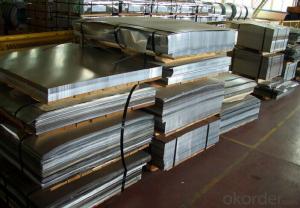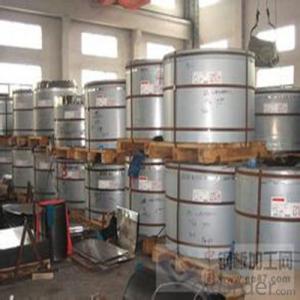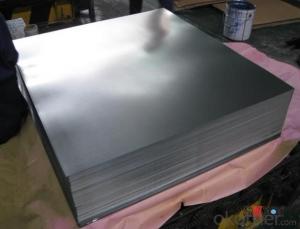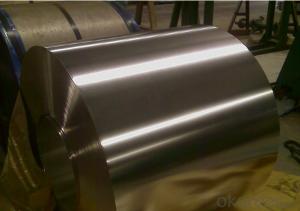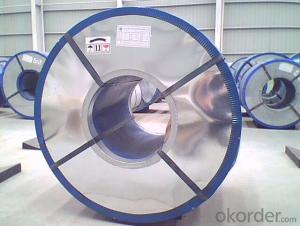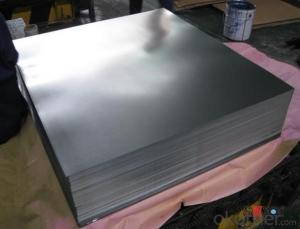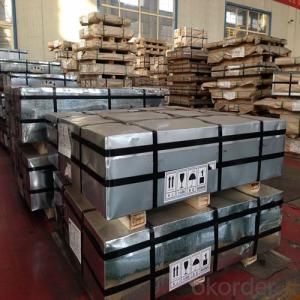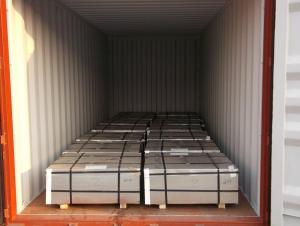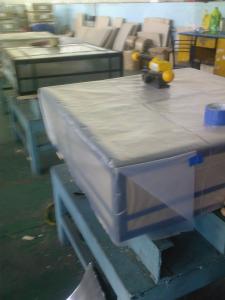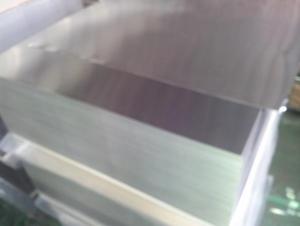Electrolytic Tinplate (ETP) for Foods and Chemical Packaging
- Loading Port:
- Tianjin
- Payment Terms:
- TT OR LC
- Min Order Qty:
- 25 m.t.
- Supply Capability:
- 20000 m.t./month
OKorder Service Pledge
OKorder Financial Service
You Might Also Like
1.Structure of Electrolytic Tinplate (ETP) for Foods and Chemical Packaging Description
Electrolytic Tin Plate Coils and Sheets for Foods Metal Packaging, is one thin steel sheet with a coating of tin applied by electrolytic deposition. Tinplate made by this process is essentially a sandwich in which the central core is strip steel. This core is cleaned in a pickling solution and then fed through tanks containing electrolyte, where tin is deposited on both sides. As the strip passes between high-frequency electric induction coils, it is heated so that the tin coating melts and flows to form a lustrous coat.
2.Main Features of the Electrolytic Tinplate (ETP) for Foods and Chemical Packaging
Appearance – Electrolytic Tin Plate is characterized by its beautiful metallic luster. Products with various kinds of surface roughness are produced by selecting the surface finish of the substrate steel sheet.
Paintability and printability – Electrolytic Tin Plates have excellent paintability and printability. Printing is beautifully finished using various lacquers and inks.
Formability and strength – Electrolytic Tin Plates have got very good formability and strength. By selecting a proper temper grade, appropriate formability is obtained for different applications as well as the required strength after forming.
Corrosion resistance – Tinplate has got good corrosion resistance. By selecting a proper coating weight, appropriate corrosion resistance is obtained against container contents. Coated items should meet 24 hour 5 % salt spray requirement.
Solderability and weldability – Electrolytic Tin Plates can be joined both by soldering or welding. These properties of tinplate are used for making various types of cans.
Hygienic – Tin coating provides good and non toxic barrier properties to protect food products from impurities, bacteria, moisture, light and odours.
Safe – Tinplate being low weight and high strength makes food cans easy to ship and transport.
Eco friendly – Tinplate offers 100 % recyclability.
Tin is not good for low temperature applications since it changes structure and loses adhesion when exposed to temperatures below – 40 deg C.
3.Electrolytic Tinplate (ETP) for Foods and Chemical Packaging Images
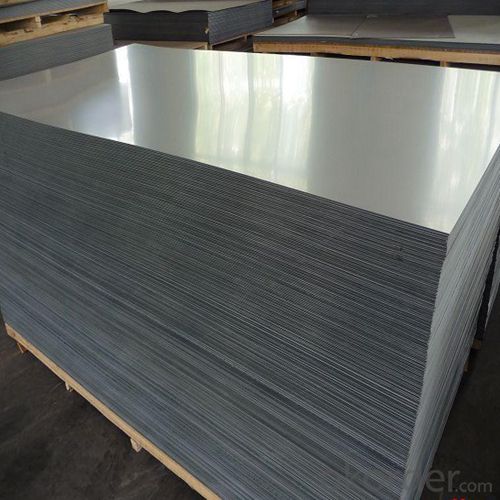
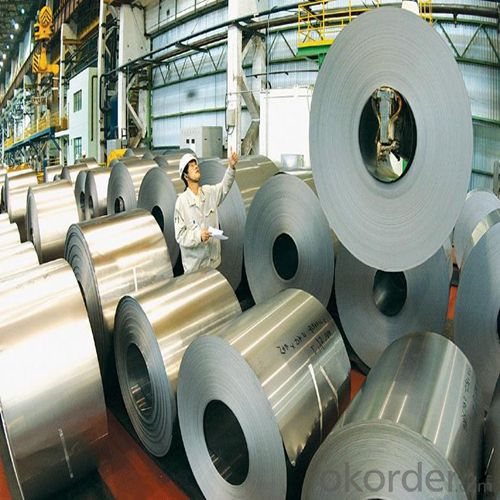
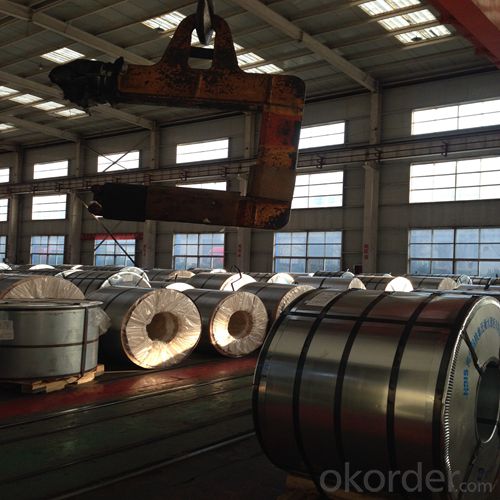
4.Electrolytic Tinplate (ETP) for Foods and Chemical Packaging Specification
Standard | ISO 11949 -1995, GB/T2520-2000,JIS G3303,ASTM A623, BS EN 10202
|
Material | MR,SPCC |
Thickness | 0.15mm - 0.50mm |
Width | 600mm -1150mm |
Temper | T1-T5 |
Annealing | BA & CA |
Coil Inner Diameter | 508mm |
Weight | 6-10 tons/coil 1~1.7 tons/sheets bundle |
Passivation | 311 |
Oil | DOS |
Surface | Finish,bright,stone,matte,silver |
5.FAQ of Electrolytic Tinplate (ETP) for Foods and Chemical Packaging
-How to place .an order or contact you ?
Please send us Email. we will give you a quick response in seconds .
- How is your quality ?
All our quality is prime even the secondary quality . We have many years experience
In this field with serious quality control standard . Advanced equipment, We welcome your visit to our factory .
- Q: Is tinplate safe for food contact?
- Yes, tinplate is safe for food contact. It is widely used in the packaging industry for food and beverage cans as it provides a protective barrier that prevents contamination and preserves the quality and safety of the food inside.
- Q: How is tinplate coated for furniture?
- Tinplate is coated for furniture by applying a thin layer of tin to a steel sheet through an electroplating process, forming a protective and decorative coating.
- Q: Is tinplate resistant to scratches and dents?
- Yes, tinplate is resistant to scratches and dents.
- Q: Can tinplate packaging be used for promotional items?
- Yes, tinplate packaging can definitely be used for promotional items. Tinplate packaging is a versatile and customizable option that can be designed to display brand logos, messages, and captivating visuals. It provides a durable and attractive packaging solution that can enhance the perception of the promotional item and leave a lasting impression on recipients.
- Q: How does tinplate compare to other packaging materials in terms of brand recognition?
- Tinplate is a highly recognizable packaging material that offers excellent brand recognition. Its shiny and durable surface stands out on the shelves, making it instantly identifiable and associated with quality. Unlike other packaging materials, such as plastic or paper, tinplate provides a unique and premium look that can enhance a brand's image and help it stand out from the competition.
- Q: Does tinplate require any specific handling or storage conditions?
- Yes, tinplate does require specific handling and storage conditions. It should be protected from moisture and kept in a dry environment to prevent rusting. Additionally, it is recommended to store tinplate in a cool and well-ventilated area to maintain its quality and prevent any potential damage.
- Q: What is the recycling process for tinplate?
- The recycling process for tinplate typically involves collecting the tinplate packaging, separating it from other materials, such as paper or plastic, and then shredding or melting it down to remove any coatings or impurities. The clean tinplate is then compressed into bales or melted into molten metal, which can be used to produce new tinplate products.
- Q: How does tinplate contribute to the overall reusability of packaging?
- Tinplate contributes to the overall reusability of packaging due to its durable and long-lasting nature. It can be easily cleaned and reused multiple times without losing its structural integrity, making it an ideal material for packaging that can be used again and again. Additionally, tinplate is highly resistant to corrosion, ensuring that the packaging remains in good condition for extended periods. Its reusability helps reduce waste and promotes sustainable practices in the packaging industry.
- Q: How has tinplate evolved over the years?
- Tinplate has evolved significantly over the years with advancements in production techniques and technology. Initially, tinplate was made by hand, resulting in inconsistent quality and limited production. However, with the development of mechanized processes, tinplate production became faster, more efficient, and cost-effective. Additionally, improvements in tin coating methods have enhanced the durability and corrosion resistance of tinplate. Nowadays, tinplate is produced using high-speed mills and advanced coating technologies, ensuring consistent quality, customization options, and increased market demand.
- Q: What are the common printing methods used on tinplate?
- The common printing methods used on tinplate include lithography, offset printing, and screen printing.
Send your message to us
Electrolytic Tinplate (ETP) for Foods and Chemical Packaging
- Loading Port:
- Tianjin
- Payment Terms:
- TT OR LC
- Min Order Qty:
- 25 m.t.
- Supply Capability:
- 20000 m.t./month
OKorder Service Pledge
OKorder Financial Service
Similar products
Hot products
Hot Searches
Related keywords











